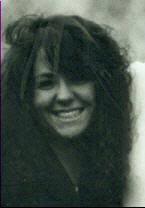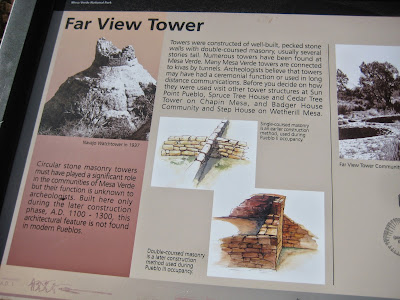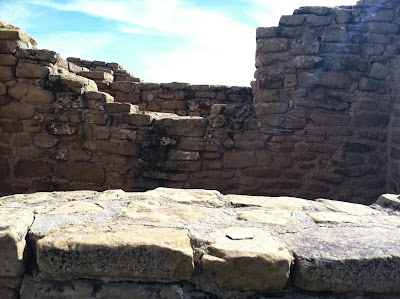Far View was one of the most densely populated parts of the mesa from A.D. 900 to about A.D. 1300. Nearly 50 villages have been identified within a half square mile area, and were home to hundreds of people. Today, several excavated and stabilized sites are linked by a trail system within a short walking distance. These surface sites include Far View House, Pipe Shrine House, Coyote Village, Far View Reservoir, Megalithic House, and Far View Tower.
Jesse Walter Fewkes of the Smithsonian Institution in Washington began excavation and stabilization in the Far View group in 1916 with Far View House. He excavated Far View Tower in 1921 and Megalithic House and Pipe Shrine House in 1922. The field school of the University of Colorado excavated Coyote Village during the 1968 and 1969 field seasons and Mummy Lake during the 1969 season.
Far View Tower...
One of the last sites Dr. Fewkes excavated in Mesa Verde was Far View Tower. It consists of a rectangular row of sixteen small, one-story rooms, three kivas, and a round tower. In his 1922 report on the excavation, Dr. Fewkes wrote the following about Far View Tower:
This building is situated north of Far View House, about midway between it and Mummy Lake, and when work began on it no walls were visible; the site was covered with sage bushes, and fallen stone strewn over the surface had raised a mound a few feet high, which is now a fine circular tower surrounded by low walled basal rooms. Three kivas were revealed on the south side where formerly no evidence of their existence appeared.
The remains of the Far View Tower suggest that this village was also occupied during two separate periods. The sixteen rooms north of the tower have the earlier single course masonry. Two of the three kivas found were built at the same time as these rooms. The tower however, has double course masonry.
There were originally three kivas, a round tower, and sixteen rooms in this site. One of the original kivas was abandoned and filled with trash by the villagers. Later, the people built the third kiva and the tower over part of the earlier, trash-filled kiva. This is why we see only two kivas at this site today.
From the size of the mound and the amount of rubble around it, Dr. Fewkes believed the tower once stood as high as the surrounding trees.
Archeologists have found the remains of 57 towers in Mesa Verde. There are several theories about the construction of these towers. Towers are circular and some are connected to kivas. Many archeologists believe towers were ceremonial in use. Others believe they may have served as signal towers or as watchtowers. Perhaps the towers served as a place to observe the sun's position and keep track of planting and harvesting seasons or ceremonial cycles.
Far View Reservoir...The feature known as Mummy Lake may have been a reservoir or a ceremonial site.
Mummy Lake is a circular depression 90 feet (27 meters) in diameter and 12 feet (3.6 meters) deep when in use, surrounded by a circular wall with artificial banks on the south and east sides. The masonry walls suggest two construction periods -- one between A.D. 900 and 1100 and another between A.D. 1100 and 1300. Archeologists studied pottery shards (pieces) to determine the time during which this feature may have been used. These shards suggest the Ancient Puebloans used this feature right up until the abandonment of Mesa Verde.
The reservoir theory indicates this feature was filled through the gap on the west end, near the present road. Although there is no evidence of an outlet, some researchers believe a ditch ran from this area to the canyon immediately above Spruce Tree House. They believe that such a ditch could have been used to transport irrigation water along the five miles (eight kilometers) between the Far View complex and Spruce Tree House.
Megalithic House...
In 1922 Dr. Fewkes excavated Megalithic House, named for the large stones in one or two rooms near the kiva. Although archeologists found evidence of eight or nine rooms and a kiva, only one or two rooms had large stones set on edge to form the base of a wall. The other rooms had single course masonry walls. Megalithic House may be all that remains of a larger village.
Although uncommon in the region, Dr. Fewkes reported villages similar to Megalithic House have been found on the bluff overlooking the junction of Yellow Jacket and McElmo Canyons west of Cortez and in other areas in the San Juan Valley. Recent archeological excavations have reported similar villages, all dating to approximately the same period of occupation.
The kiva at Megalithic House is an excellent example of a Late Developmental Pueblo kiva. Note the "keyhole" shape and the excellent stone work of the walls of the kiva. The builders cut through the bedrock to make the floor of this kiva level.
Far View House...
Far View House is a large, rectangular pueblo consisting of about 40 ground floor rooms, an undetermined number of upper story rooms, and five kivas, or ceremonial chambers. Four of these kivas are within the building walls, while one is located outside the walls. Modern archeological dating techniques were unknown when this dwelling was excavated in 1916. However, later examination of the artifacts and the masonry style suggests that Far View House was built and occupied between A.D. 1100 and 1300 -- during the Classic Pueblo Period of Mesa Verde Ancestral Puebloan occupation. One can see evidence that Far View House was at least two stories high in many places.
A striking feature of Far View House is the regularity and size of its rooms. There is a definite pattern of their construction and how evenly they are spaced.
By looking through the entryways and entering these rooms, you can get an idea of room size in a Classic Pueblo village.
Rooms in Far View House are larger and have larger entryways than rooms in the cliff dwellings of Mesa Verde.
The higher walls in the center of the site north of the large kiva are the remains of second story walls.
Far View House was constructed where earlier people had discarded trash. The walls soon settled into the soft trash mound, making repair work necessary.
This larger kiva appears to be the oldest of the four kivas within the walls of Far View House. It most resembles Chacoan kivas in size. The low pilasters (pillars) for roof supports, the very tall walls, and the two vaults on the floor are all "borrowed" features from Chaco Canyon kivas.
While excavating Far View House in 1916, Dr. Fewkes became interested in a large mound to the south. In the spring of 1922 he began to excavate this site. This one-to-two story village contained about 20 ground floor rooms. Although no evidence of a second story exists, walls several stones wide provide an ample foundation for one. Walls on the north side of the dwelling are examples of single course masonry (one stone wide). The people constructed their village in an L-shape, typical of a Mid-to-Late Developmental Pueblo dwelling (A.D. 1000 to 1100). The rest of the dwelling contains double course masonry (walls two or more stones wide), a common characteristic of Classic Pueblo dwellings.
Dr. Fewkes named this site Pipe Shrine House because in a pit in the kiva he found a dozen decorated clay pipes. Archeologists believe the people smoked these pipes ceremonially rather than for pleasure, as is practiced by native peoples today.
Below is a view of Pipe Shrine House looking across from Far View House...
Because Pipe Shrine House contains both single and double course masonry, archeologists believe it was occupied from A.D. 900 - 1300. As the population of the village increased, the people may have remodeled and added on extra rooms using the newer double coursed masonry technique. Another idea is that the original villagers left the pueblo. Later a second group moved in and used different construction techniques.
The low bench, high walls, and different ventilation system are characteristics of Chacoan kivas. The kiva was surrounded by rooms, and its flat roof served as a central courtyard inside the village. The only entrance to this courtyard and to the rooms of Pipe Shrine House is an entryway in the south wall of the pueblo. Excavators found burned timbers and roof debris, suggesting the roof burned and the kiva was never reused. Archeologists believe that a tower stood beside the kiva. Today the remains of this tower, larger than many in Mesa Verde, looks like a circular room within the village.
The unique kiva, large tower, and interesting artifacts all led Dr. Fewkes to believe that Pipe Shrine House served as a ceremonial building rather than a typical dwelling.
Dr. Fewkes found twelve undisturbed human burials in Pipe Shrine House. The bodies lay buried in fully extended positions with pottery and other grave goods placed beside them. The fully extended position is unusual for Mesa Verde burials. In most Mesa Verde burials, the body is in a flexed or fetal position.
Coyote Village...
Coyote Village is the most recently excavated village open for public display in Mesa Verde National Park. The University of Colorado excavated this village during the 1968 and 1969 seasons.
Coyote Village consists of some 30 ground floor rooms, five kivas, and a circular tower. 40 to 50 people probably occupied the village you see here in the A.D. 1000's. Much of the stone work is single course masonry.
During excavation, archeologists uncovered evidence of an earlier occupation of this site during the A.D. 800's or 900's. Some walls are also double course masonry suggesting some construction or remodeling during the Classic Pueblo Period. Double course walls may have supported second story rooms, but there is no evidence of this in Coyote Village.
Kivas in the center and west end of the building all have tunnels connecting them with other features and with each other.
The floor of the kiva on the extreme east of the ruin, was built at ground level. The people never used, or even completed, this kiva.
Looking west from the rim of the unfinished kiva (on the right)...
These pictures are the ground-floor rooms at the north end of the village...
One of the kivas on the south end...
Subscribe to:
Post Comments (Atom)












































No comments:
Post a Comment